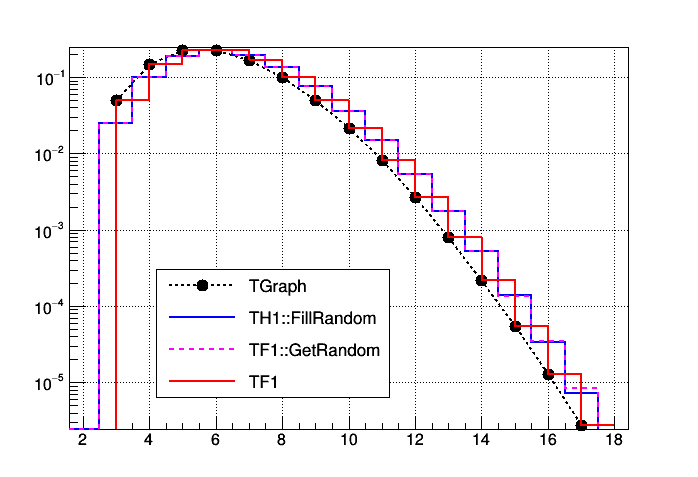Hi,
I have a complicated discrete PDF from which I want to draw random numbers.
I tried to use the usual approach of defining a TF1 and then either TH1::FillRandom or TF1::GetRandom, but I don’t get the correct result.
Here’s the PDF class:
struct WattsStrogatz {
double operator()(double *x, double *par) {
int k = x[0];
int N = par[0];
int K = par[1];
double p = par[2];
double P = 0;
for (int n = 0; n <= min(k-K, K); ++n) {
P += ROOT::Math::binomial_pdf(n, 1-p, K) *
ROOT::Math::poisson_pdf(k-K-n, p*K);
}
return P;
}
};
and here’s a minimal working macro:
{
int N = 1e3, K = 3;
double p = 0.99;
TF1 *f = new TF1("f", WattsStrogatz(), 0, 18, 3);
f->SetParameters(N, K, p);
f->SetNpx(3600);
TGraph *g = new TGraph(18-K);
g->SetMarkerStyle(kFullCircle);
g->SetMarkerSize(1.4);
g->SetLineStyle(2);
g->SetLineWidth(2);
for (int i = 0; i < g->GetN(); ++i) {
double k = i + K;
g->SetPoint(i, k, f->Eval(k));
}
TH1F *h = new TH1F("h", "", 18, -0.5, 17.5);
h->SetLineColor(kBlue);
h->SetLineWidth(2);
h->FillRandom("f", 1e7);
TH1F *h2 = new TH1F("h2", "", 18, -0.5, 17.5);
h2->SetLineColor(kMagenta);
h2->SetLineWidth(2);
h2->SetLineStyle(7);
for (int i = 0; i < 1e7; ++i) {
h2->Fill(f->GetRandom());
}
g->Draw();
gPad->SetLogy();
gPad->SetGrid();
h->DrawNormalized("hist same");
h2->DrawNormalized("hist same");
f->Draw("same");
}
This is the result:
Note that the histogram entries are enough to get a statistical uncertainty of around 1% in the last bin, but both histograms are systematically higher than the TGraph and TF1.
This problem happens with any combinations of the PDF parameters.
Any ideas?
ROOT Version: 6.20
Platform: Ubuntu
Compiler: gcc
